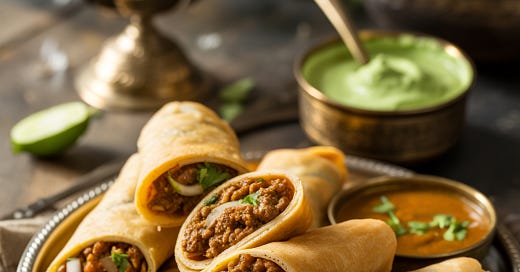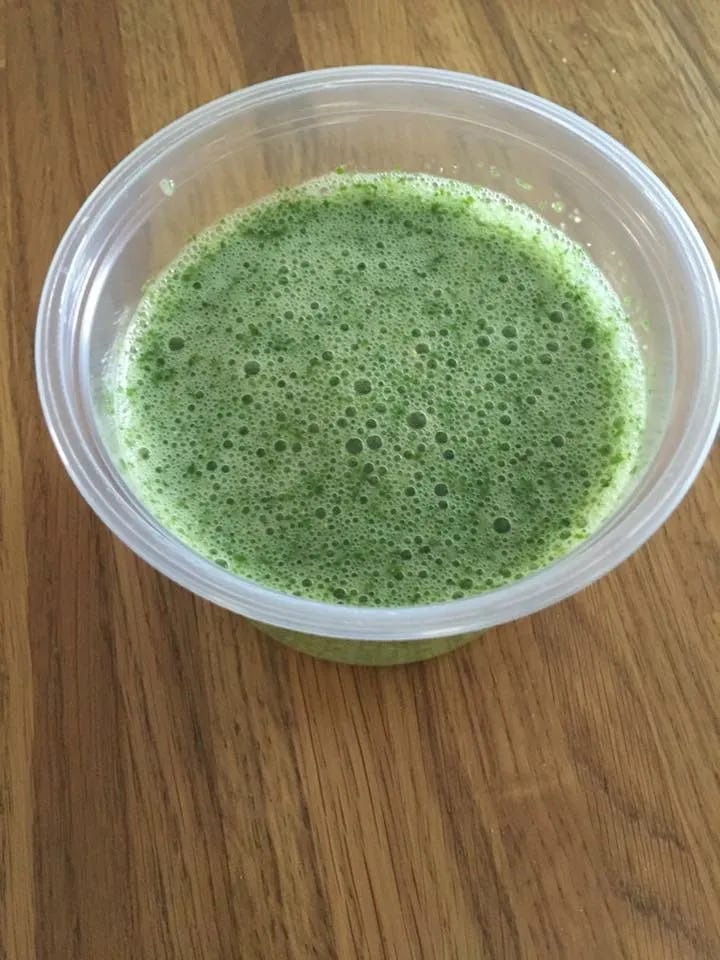Pantras: A Jewish Blintz in a Curry World
As approved by Aunt Rahele’s recipe, with TikTok palates in mind
Again I write, as I sit with neighbors in an Anne Frank–sized closet — a MAMAD, Israel’s reinforced security room.
Late last week, Israel struck Iran’s nuclear program — a last-minute attempt to stop a regime that has vowed to destroy the “Little Satan” from enriching uranium (or, as I call it, Iran-ium) to weapons-grade levels. Iran has responded by launching hundreds of drones, rockets, and ballistic missiles at civilian centers across Israel.
I’ve come to be with my elderly mother — so she doesn’t have to go through this madness alone. And in the past week, I’ve met her neighbors more than in all the years before — three, sometimes four times a night.
It’s 3 a.m. We’re huddled again in the MAMAD. About twelve of us, sitting on plastic chairs pressed against whitewashed concrete walls. The electric fan hums quietly.
I look around. I know them all now.
The young woman with the stray dog she rescued.
The doctor and his wife, softly reciting psalms.
My mother, playing Wordle on her iPhone with the kids of a young family from the top floor.
Each person has their own warning app.
Each app has its own distinct beep.
And in the middle of the night, amid bleary-eyed silence, the electric fan and those are the only sounds we hear—until the distant booms of the Iron Dome break the night open.
They call it a “safe room.” But whether it’s safe or not depends entirely on whether we come out unscathed.
In this surreal situation, my pen is my sword. I shall not fear.
And so, I write about Pantras — a dish as hybrid, resilient, and quietly defiant as the people who made it.
Pantras is one of those foods that wears many masks. It looks like a crepe, behaves like a spring roll, and tastes like no other Jewish dish you’ve likely encountered. It’s golden, crisp, warmly spiced, and stuffed with turmeric-scented meat. It’s made for Shabbat—prepared in advance, fried just before sundown, and served with hulba, a pungent fenugreek relish. And yet, you won’t find it in Iraq, even though it comes from the Iraqi Jewish community.
That’s because Pantras was invented in India.
And yes—Pantras is both singular and plural. One Pantras. Five Pantras. (Even if your grandson insists on “pantrasses,” tell him that even cactus has “cacti.”)
More precisely, it’s a product of the Baghdadi Jewish community of Calcutta: a now nearly-vanished group that settled there in the late 18th and 19th centuries after fleeing persecution and economic hardship in the Ottoman Empire. These Jews—Arabic-speaking, mercantile, fiercely proud—brought their rituals and customs with them, but no one arrives unchanged. Calcutta, a bustling colonial port city, was a world of British bureaucracy, Bengali markets, and a kaleidoscope of immigrant groups. In that mix, Baghdadi Jews adapted—religiously, linguistically, and culinarily.
Pantras is what happens when a Jewish memory of Sabbath crepes meets the Indian technique of shallow-frying and the colonial pantry of wheat flour, tinned ghee, and local spices. It’s not mentioned in any Iraqi cookbooks or oral histories. Its roots appear only in Calcutta and later Bombay—both places where Baghdadi Jews established strong communities under the British Raj.
In Beyond Babylon, our community cookbook tracing the Jewish diaspora in South and Southeast Asia, I asked elders about Pantras. Almost all attributed it to Calcutta. Aunt Rahele, who lives in Canada, recalled it as a dish her mother made for Friday nights. “It wasn’t something from Baghdad,” she insisted. “This was our Indian food, Jewish food, Calcutta food.”
What does the name mean? The answer is uncertain. Some suggest a connection to the Arabic patras or patira, related to something thin or wrapped. Others suspect a colonial neologism—perhaps an Anglo-Indian corruption of pâté or pantry. The truth is, we don’t know. Like many diasporic foods, its name is part of its mystery.
The preparation is deceptively simple. A batter of flour, egg, and water is blended, rested, and then swirled into thin pancakes—not quite as lacy as a French crêpe, not as thick as an American flapjack. A filling of ground meat, onion, turmeric, and fresh coriander is sautéed until aromatic but not dry. The pancakes are filled, rolled into cigars, dipped in egg and breadcrumbs, and fried until golden.
There are rules, of course. Aunt Rahele insists that parsley is never used—only fresh coriander. The filling must be moist when assembled, as it will dry out in the frying pan. And never, under any circumstances, should they be baked. “Someone in London served me baked Pantras. It was disgusting. Slimy. It ruined the whole thing.”
Once cooked, Pantras is served with hulba, a tangy fenugreek emulsion that traveled with Yemenite Jews to India via Aden. How it got adopted into Baghdadi kitchens is unclear, but there it remains, a bold counterpoint to the gentle heat of the rolls. The pairing tells a story of Jewish sub-communities meeting and mingling in the shadow of Empire.
At its core, Pantras is about memory—rolled up, sealed with egg, and crisped into resilience. It reminds us that Jewish food doesn’t always come from a motherland. Sometimes it’s born in the ports of Calcutta, under the smells of mustard seed and fried onions, with British missionaries down the road and Bengali sweet shops on every corner.
It’s a dish that had to invent itself—just like the community who made it.
🥘 Recipe: Pantras (Baghdadi Jewish Spiced Pancake Rolls)
Source: Aunt Rahele
Serves: 8–10
🍜 Filling:
1 tbsp neutral oil (corn, sunflower, or peanut)
1 cup (150g) finely chopped onion
450g ground beef or chicken
½ tsp turmeric
½ tsp salt (or to taste)
¼ tsp black pepper
1 tbsp chopped fresh cilantro (sorry, not parsley!)
Note: The filling should be moist, not dry. It will dry out more during frying, so don’t overcook.
🥞 Pancake (Wrapper) Batter:
125g (1 cup) all-purpose flour
300ml (1¼ cups) cold water
1 small egg
½ tsp salt
1 tsp neutral oil (into the batter)
Blend all batter ingredients in a blender until smooth. Let rest 20 minutes before using.
🍳 To Make Pancakes:
Use an 8-inch pan (base ~6 inches)
Brush pan lightly with oil and heat over medium
Pour in a small ladleful (less than ¼ cup) of batter, swirling to coat
Cook on one side, flip, then cook the other side—no raw bits!
Transfer pancakes to a board to cool before filling
⚠️ Pancake technique improves with experience. The goal is thin, flexible wrappers that don’t tear.
🪜 Breading & Frying:
1 egg, beaten
½ tsp neutral oil mixed into the egg
100g (1 cup) fine breadcrumbs (I like to use panko)
Neutral oil for shallow frying
The oil in the egg helps the crumbs stick better.
🧑🍳 Assembly:
Place 1 tbsp of filling on the edge of each pancake
Roll over once, fold in the sides, and roll tightly into a cigar
Dip in egg mixture, coat with breadcrumbs
🔥 Frying:
Fry over medium heat in shallow oil until golden and crisp on all sides
Do not drain on paper towels! Use a cooling rack or trivet set over a cutting board lined with paper towel to allow oil to drain naturally and preserve texture
❄️ If using frozen Pantras, allow them to thaw before frying.
🚫 Do not bake—Aunt Rahele says baked Pantras are “disgusting” and develop a slimy texture.
To Serve:
Traditionally served with hulba—the Jewish Indian version of Yemenite hilbeh (fenugreek dip).
📥 Want to cook it yourself?
Download the printable PDF recipe card and bring this Indian-Jewish classic into your kitchen:
👉 Pantras Recipe Card PDF
📥 Want to cook it yourself?
Download the PDF recipe card for Pantras and keep this Indian-Jewish classic in your kitchen:






Stay safe. Our prayers are with you all.
Thank you, Diane. That means a lot.
Yes, I seem to be walking a fine line — just trying to speak honestly from a place of pain and witness, while the internet demands sides, slogans, and scapegoats.
Even a quiet, thoughtful post can become a lightning rod if it dares to sound human in an inhuman time.
The irony isn’t lost on me. I didn’t bomb Iran. I don`t kill children. I just posted a recipe. But that seems enough these days to invite a barrage.
I’m still figuring out how much to engage, and when to step back. But support like yours reminds me I’m not entirely alone out here. So thank you again.